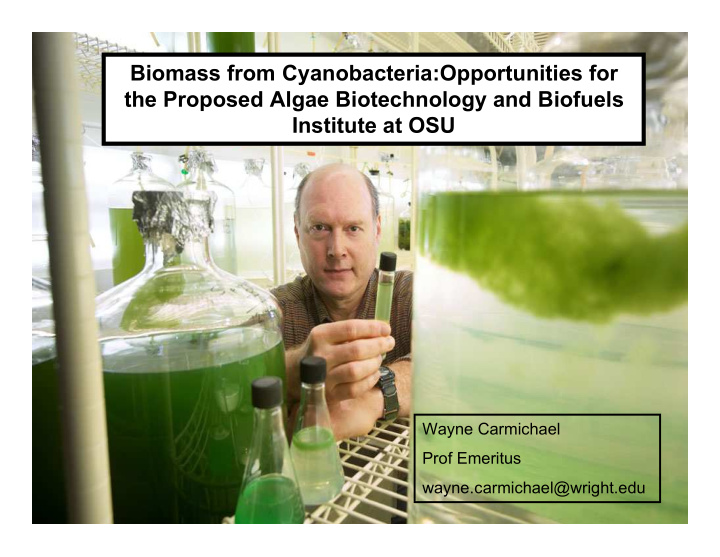



Biomass from Cyanobacteria:Opportunities for the Proposed Algae Biotechnology and Biofuels Institute at OSU Wayne Carmichael Prof Emeritus wayne.carmichael@wright.edu
Their unicellular/colonial morphology, prokaryotic nature with lack of sexual cycle and relative ease of culture in defined media make them good candidates for large scale biomass
Semicontinuous batch culture, continuous culture-in lab or in field
90 Liter-Bioreactor- Continuous Culture
High biomass natural waterblooms or cultured ponds There is a long history for the use of cyanobacteria as food, feed stocks and as a medicinal
High Biomass can also lead to Harmful Algal Blooms (HABs) Produce dense blooms leading to oxygen stress. – Dinoflagellates – Cyanobacteria (prokaryotic microbes) Produce potent toxins—illness and death via food chain or biomass accumulation. – Paralytic shellfish poisoning (PSP) – Diarrheal shellfish poisoning (DSP) – Neurotoxic shellfish poisoning (NSP) Dinoflagellate – Ciguatera fishfood poisoning (CFP) – Estuary-associated syndrome (EAS) – Amnesic shellfish poisoning (ASP) Diatom – Cyanobacteria toxin poisoning (CTP)
WATER QUALITY ADVISORY UPDATE LARISON COVE IS RE-0PEN AND UPPER PACKARD ARM REMAINS CLOSED DUE TO ALGAE BLOOM AND GENERAL ADVISORY REMAINS FOR HILLS CREEK RESERVOIR August 2, 2002 Larison Cove re-opens but citizens are advised to avoid contact w ith the water at Upper Pac kard Arm. For the entire Reservoir, one should avoid high con centrations of blue-green algae both on the water surface or shor eline . Humans and pets are at the highest risk when water is ingeste d (swallowed either deliberate or incidental ) from the areas of high algae concentrations. Water testing confirmed the algae to be a species having the ab ility to produce toxins. Cont inued monitoring and laboratory tests have confirmed high concentrations of the algae in the Upper Packard Arm. The situation is likel y to change as visual monitoring and water test results confirm algae concentrations.
Diamond Lake, Oregon--Anabaena flos-aquae waterbloom - Antx-a June-August 2002
Bioactive Metabolites-Of The Cyanobacteria Cytotoxins—Toxins with cytotoxic (cellular) effects “Toxins” with acute, acute-lethal, or chronic biological effects
Cytotoxic Pharmacologicals Sampling of activities-Cytotoxic (virus, bacteria, fungi, algae, worms), Antitumor, Cardioactive, Antiinflammatory, Antimitotic, Sunscreen Ref: Namikoshi/Rinehart 1996, Burja et al. 2001, Gerwick et al. 2001, Harada et al. 2003
Cyanotoxins— Mode of Action Neurotoxins Hepatotoxins Dermatoxins
Neurotoxins Anatoxin-a Anatoxin-a(s) Saxitoxins
Hepatotoxic Microcystins
Cylindrospermopsin Cylindrospermopsis
Dermatoxins (Marine) Protein Kinase Activator
US EPA Ranking of Cyanotoxins- Based upon Occurrence and Health Significance Microcystins (most common of (most common of Microcystins cyanotoxins; widespread ; widespread cyanotoxins poisonings). poisonings). Anatoxins (common; with animal (common; with animal Anatoxins poisonings). poisonings). Cylindrospermopsins (widespread in (widespread in Cylindrospermopsins U.S.; poisonings from Australia). U.S.; poisonings from Australia). Lyngbyatoxins (possible presence in (possible presence in Lyngbyatoxins continental U.S.; poisonings in continental U.S.; poisonings in South and Central Pacific). South and Central Pacific). Nodularins (unknown in NA; some (unknown in NA; some Nodularins animal deaths internationally). animal deaths internationally). Saxitoxins (sporadic; with some Saxitoxins (sporadic; with some animal deaths). animal deaths). BMAA (world wide; but health BMAA (world wide; but health significance largely unknown). significance largely unknown). LPS (world wide; unknown). LPS (world wide; unknown).
Needed Studies on Toxic Cyanobacteria World-wide occurrence and distribution Management of Laboratory Isolation Molecular Toxic blooms and Culture Taxonomy Molecular Biotoxins Cytotoxins Taxonomy for standards (Drug Discovery) development of rapid assays • Isolation • Toxicology • Production • Purification • Pharmacology • Regulation (genetic) • Chemical Identification • Risk Assessment • Role • Risk Management
Summary-Uses of Cyanobacteria Biomass- Based on the Five Focus Areas for the Institute • Bioremediation-i.e. heavy metals, pesticides, nutrients • Water Management-CyanoHABs • Biofuels-Hydrogen, but not good for alcohol or biodiesel • Bioproducts-pharmacologicals, cyanotoxins • Carbon Sequestration-biomass
Recommend
More recommend